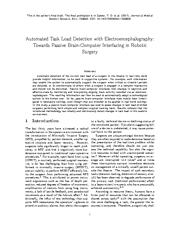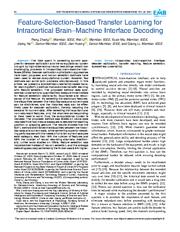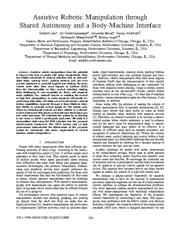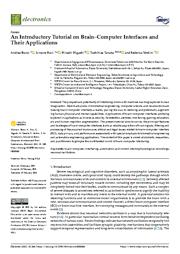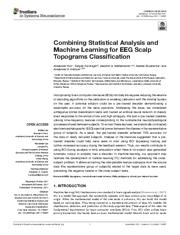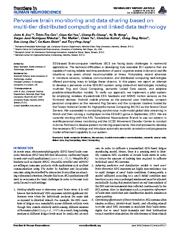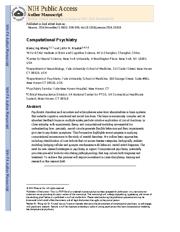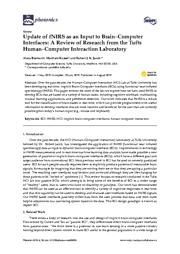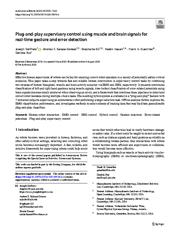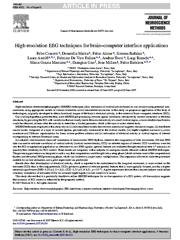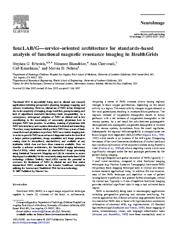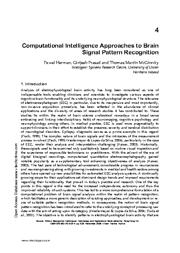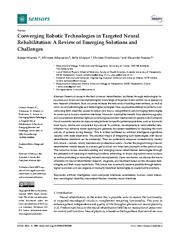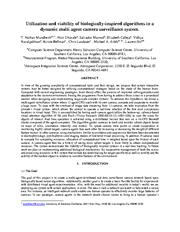A copy of this work was available on the public web and has been preserved in the Wayback Machine. The capture dates from 2018; you can also visit the original URL.
The file type is application/pdf.
Filters
Automated Task Load Detection with Electroencephalography: Towards Passive Brain–Computer Interfacing in Robotic Surgery
2017
Journal of Medical Robotics Research
Passive brain-computer interfaces infer changes in cognitive and a↵ective state by monitoring and interpreting ongoing brain activity recorded via an electroencephalogram. ...
In this study, a passive brain-computer interface was used to assess changes in task load of skilled surgeons performing both simple and complex surgical training tasks. ...
Acknowledgments The authors would like to thank Brain Products GmbH for supporting us with a BrainAmp DC and a BrainAmp Move system, such that we could record the EEG for this study. ...
doi:10.1142/s2424905x17500039
fatcat:3zonsoxy6zhv5j5x2uqdm6w3ri
Feature-Selection-based Transfer Learning for Intracortical Brain-Machine Interface Decoding
2020
IEEE transactions on neural systems and rehabilitation engineering
The time spent in collecting current samples for decoder calibration and the computational burden brought by high-dimensional neural recordings remain two challenging problems in intracortical brain-machine ...
Decoder calibration optimization approaches have been proposed, and neuron selection methods have been used to reduce computational burden. ...
TL has been widely used in EEG-based brain-machine interface to transfer knowledge from session to session or subject to subject [37] - [40] , however, it is rarely applied in iBMIs. ...
doi:10.1109/tnsre.2020.3034234
pmid:33108289
fatcat:dpsqsmd4mzgzlahlucvz7mwate
Assistive robotic manipulation through shared autonomy and a Body-Machine Interface
2015
2015 IEEE International Conference on Rehabilitation Robotics (ICORR)
We evaluated the system by conducting a user study in which 6 participants performed 144 trials of a manipulation task using the BMI interface and the proposed shared-control framework. ...
Our research focuses on enabling the control of high-DoF manipulators to motor-impaired individuals for performing daily tasks. ...
ACKNOWLEDGMENT This research was supported by NIBIB grant R01-EB019335, NICHHD grant 1R01HD072080 and NIDRR grant H133E120010. ...
doi:10.1109/icorr.2015.7281253
pmid:26855690
pmcid:PMC4737957
fatcat:falazb3orrewfdi7xudj3h3epm
An Introductory Tutorial on Brain–Computer Interfaces and Their Applications
2021
Electronics
The present tutorial aims to survey the principal features and challenges of brain–computer interfaces (such as reliable acquisition of brain signals, filtering and processing of the acquired brainwaves ...
The content of this paper is aimed at students, researchers, and practitioners to glimpse the multifaceted world of brain–computer interfacing. ...
Instead of relying on brain activity from one subject, the system proposed by the authors of [106] utilized brain activity from eight subjects performing a single trial. ...
doi:10.3390/electronics10050560
fatcat:g2d57exmcbghlkf2rekmgdjhae
Combining Statistical Analysis and Machine Learning for EEG Scalp Topograms Classification
2021
Frontiers in Systems Neuroscience
Incorporating brain-computer interfaces (BCIs) into daily life requires reducing the reliance of decoding algorithms on the calibration or enabling calibration with the minimal burden on the user. ...
As a result, the pre-trained classifier achieved 74% accuracy on the data of newly recruited subjects. ...
These aspects of ML meet the fundamental requirements for brain-computer interfaces (BCIs). First, BCI often utilizes brain activity biomarkers that barely have an exact mathematical model. ...
doi:10.3389/fnsys.2021.716897
pmid:34867218
pmcid:PMC8635058
fatcat:4uflptltfvf4bj6rssb7hg7mie
Pervasive brain monitoring and data sharing based on multi-tier distributed computing and linked data technology
2014
Frontiers in Human Neuroscience
EEG-based Brain-computer interfaces (BCI) are facing basic challenges in real-world applications. ...
, compact personal computers as the near-end Fog Servers and the computer clusters hosted by the Taiwan National Center for High-performance Computing (NCHC) as the far-end Cloud Servers. ...
the NCHC sponsored by the Taiwan National Research Council have all contributed to the development of this pilot system. ...
doi:10.3389/fnhum.2014.00370
pmid:24917804
pmcid:PMC4042686
fatcat:2aobkajkrnbqznqljzuksiceoy
Computational Psychiatry
2014
Neuron
The brain is enormously complex and its abundant feedback loops on multiple scales preclude intuitive explication of circuit functions. ...
This Perspective highlights recent progress in applying computational neuroscience to the study of mental disorders. ...
Acknowledgments We thank John Murray, Alan Anticevic, and Philip Corlett for discussions related to computational psychiatry and John Murry for making Figure ...
doi:10.1016/j.neuron.2014.10.018
pmid:25442941
pmcid:PMC4255477
fatcat:yscknyq4ezdfhbu2wqdlr6ch64
Update of fNIRS as an Input to Brain–Computer Interfaces: A Review of Research from the Tufts Human–Computer Interaction Laboratory
2019
Photonics
This paper reviews the work of the lab; we explore how we have used fNIRS to develop BCIs that are based on a variety of human states, including cognitive workload, multitasking, musical learning applications ...
Over the past decade, the Human–Computer Interaction (HCI) Lab at Tufts University has been developing real-time, implicit Brain–Computer Interfaces (BCIs) using functional near-infrared spectroscopy ( ...
Conclusions In the decade of investigation of fNIRS and implicit brain-computer interfaces, we have determined that the fNIRS can be a valuable tool for distinguishing among differing brain activation ...
doi:10.3390/photonics6030090
fatcat:wmotymvhivctjlvcxmy6xkkxdy
EEG-based Brain-Computer Interfaces (BCIs): A Survey of Recent Studies on Signal Sensing Technologies and Computational Intelligence Approaches and their Applications
[article]
2020
arXiv
pre-print
Brain-Computer Interface (BCI) is a powerful communication tool between users and systems, which enhances the capability of the human brain in communicating and interacting with the environment directly ...
In this study, we survey the recent literature of EEG signal sensing technologies and computational intelligence approaches in BCI applications, compensated for the gaps in the systematic summary of the ...
INTRODUCTION
An overview of brain-computer interface (BCI)
What is BCI The research of brain-computer interface (BCI) was first released in the 1970s, addressing an alternative transmission channel ...
arXiv:2001.11337v1
fatcat:cmurfjykjja3rdifr7e7cqq3wy
Plug-and-play supervisory control using muscle and brain signals for real-time gesture and error detection
2020
Autonomous Robots
This paper takes a step towards fast and reliable human intervention in supervisory control tasks by combining two streams of human biosignals: muscle and brain activity acquired via EMG and EEG, respectively ...
The resulting hybrid system is evaluated in a "plug-and-play" fashion with 7 untrained subjects supervising an autonomous robot performing a target selection task. ...
EEG-based methods for human-robot interaction Many brain-computer interfaces have made progress towards using EEG for communication with both healthy and disabled individuals (Brumberg et al. 2010 ; ...
doi:10.1007/s10514-020-09916-x
fatcat:c2h2drtftrhx5mq2arzdhf3xoi
High-resolution EEG techniques for brain–computer interface applications
2008
Journal of Neuroscience Methods
In this study we propose an application of this body of technologies, originally developed to obtain functional images of the brain's electrical activity, in the context of brain-computer interfaces (BCI ...
The processing procedure was designed in such a way that computations could be split into a setup phase (which includes most of the computational burden) and the actual EEG processing phase, which was ...
by the EU COST Project NEUROMATH (BM0601) and was supported in part by a grant from NIH (EB006356) in the USA. ...
doi:10.1016/j.jneumeth.2007.06.031
pmid:17706292
fatcat:wr6jn44cljcwvnb6e7inws7weu
funcLAB/G—service-oriented architecture for standards-based analysis of functional magnetic resonance imaging in HealthGrids
2007
NeuroImage
Further we would like to acknowledge the MR technologists of the Childerns Hospital of Los Angeles, University of Southern California, and the MR technologists and Radiologists of the Thousand Oaks Radiology ...
Acknowledgments We would like to acknowledge the kind support by the Resonance Technology Incorporation, Northridge, California, for providing their VisuStim fMRI stimulation equipment to develop and test ...
The Message Passing Interface (MPI), integrated into GT4, enables near real-time capabilities with cluster computing. ...
doi:10.1016/j.neuroimage.2007.07.001
pmid:17707204
fatcat:tssvu7gqrveirjdkbq4s2ic2ay
Computational Intelligence Approaches to Brain Signal Pattern Recognition
[chapter]
2008
Pattern Recognition Techniques, Technology and Applications
It conveys the degree of success in voluntary control of the brain activity. ...
Although the projection approaches adopted in (Shenoy et al., * In the context of EEG-based BCI, subjects receive mostly visual, auditory or haptic feedback information about their brain activity reflected ...
While the understanding of human-brain cognition process broadens the way in which the computer can perform pattern recognition tasks. ...
doi:10.5772/6238
fatcat:nveopxtjrbgvzdc7thscvqye4m
Converging Robotic Technologies in Targeted Neural Rehabilitation: A Review of Emerging Solutions and Challenges
2021
Sensors
In addition, developments in robot-assisted rehabilitation may enhance motor learning and generate movement repetitions by decoding the brain activity of patients during therapy. ...
Upon conclusion, we discuss the future directions for neural rehabilitation research, diagnosis, and treatment based on the discussed technologies and their major roadblocks. ...
Brain-Computer Interfaces BCIs refer to computer-based systems that interface with the brain to acquire, decode, and translate the brain activity of the user into control commands for various devices ...
doi:10.3390/s21062084
pmid:33809721
pmcid:PMC8002299
fatcat:jv3tjm3w2nh2xhhlymbk7lmm5i
Utilization and viability of biologically-inspired algorithms in a dynamic multiagent camera surveillance system
2003
Intelligent Robots and Computer Vision XXI: Algorithms, Techniques, and Active Vision
In view of the growing complexity of computational tasks and their design, we propose that certain interactive systems may be better designed by utilizing computational strategies based on the study of ...
Real time operation is achieved using a distributed version that runs on a 16-CPU Beowulf cluster composed of the agent computers. ...
This research is supported by the National Imagery and Mapping Agency, the National Science Foundation, the National Eye Institute, the Zumberge Faculty Innovation Research Fund, the Charles Lee Powell ...
doi:10.1117/12.515176
fatcat:qaceizmogzc7pdbibqn6z2hyoa
« Previous
Showing results 1 — 15 out of 3,887 results

